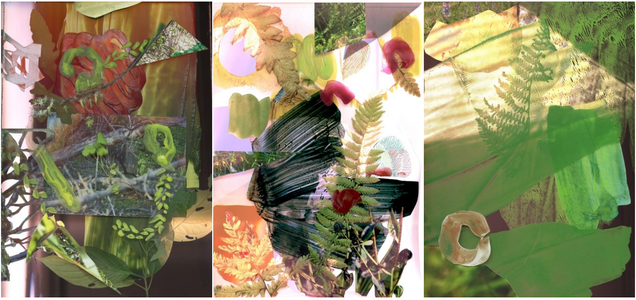Activity Guide by Kate Kwasneski, Intern, Grinnell College Museum of Art
Regan Golden’s work was featured in Grinnell College Museum of Art’s virtual exhibition, Nature, Made. She makes artworks that use color and light to represent things in nature. She uses a scanner to create her images, but before she scans them, her artworks use real plants and paint. For this project, we can use materials from nature to create art inspired by Regan Golden’s work. We are going to make nature collages.
Outdoor collages
Here are some questions to help you think about Golden’s art
- What do you see when you look at these artworks? Where do your eyes go first?
- Make a list of the things you see in the artworks. Do you know the names of any of the plants?
- What words would you use to describe the artworks?
- What kinds of shapes and colors does Regan Golden use?
- What kind of mood do they make you feel?
- Could you make up a story, poem, or song about the artworks?
Flower Pressing
You will have to press leaves and flower petals for your collage. Both botanists and artists press plants to preserve them.
Collect Your Plants
The very first step is to go outside and collect your plants! Try starting in your own yard, or at a park near your house. Take a walk and collect leaves that seem interesting to you.
Make sure to ask before you pick plants, don’t just take them from other people’s yards.
Try to only take one leaf or flower from each plant, so that you don’t hurt the plant. Most of the plant pieces I collected were actually weeds! You don’t have to find the fanciest plant to make a nice collage.
Here are some of the plants I saw while collecting bits for my collage. I decided not to pick the pink flower, since it was so pretty. You might take only a petal from a flower like this, instead of picking it. Collect all of your leaves and petals into a bag as you walk, so you don’t drop any.
Press Your Plants
Lay your pieces flat on a piece of paper. Enjoy their shapes and smells. You can use newspaper, or paper from the recycling bin. You might need more than one sheet. Make sure the plants do not overlap, and that any whole flowers are face down. It’s important to make everything as flat as possible for best results. If the leaves have wrinkles or folds when you lay them down, you won’t be able to get them out once they’ve been pressed. Stack the paper and leaves like a sandwich. Use several pieces of paper below and above each set of leaves to absorb the moisture.
Put the pages somewhere they can sit for a few days, then place another piece of paper over the top of them.
Stack some books or other heavy objects over your plants. The heavier they are, the better! If you don’t have a lot of books lying around, you could use bricks or rocks. Just make sure you won’t need the things you’re using for a few days!
Leave your pressed plants in the same spot for a while. For best results, don’t touch them for almost a week! The weight of the objects on top of them is doing the pressing, and the more time they have to complete the process, the better it will work.
Once you have left your plants to press for a few days, they’ll look like this. Wait until your plants feel completely dry and are rigid instead of flexible.
Arrange Your Collage
Next, it’s time to place your plants down onto your paper! You could use construction paper for a background if you’d like. Take time to think about how wonderful nature is, and the amazing shapes and patterns you can see in your pressed plants.
Play!
Think about whether you’d like your plants to overlap, or be separate on the page. Would you like to make a pattern out of your plants, or would you rather they be arranged randomly on a page? Think about varying the kinds of plants that are next to each other: intersperse large and small leaves and petals.
Experiment!
You could use marker or watercolor to create shapes or patterns before you glue down your plants. You could also experiment gluing colored tissue paper underneath or on top of your pressed leaves. Think about how Regan Golden adds colors and shapes to her collages.
When you are happy with your arrangement, glue your pieces down. You could also take a photo with your phone instead of gluing!
Write!
Write a poem about your collage, or tell a story about the types of nature you see in your backyard. What kinds of plants and animals can you find without leaving your backyard?
Web support:
Daniel Strong
Associate Director and Curator of Exhibitions
Grinnell College Museum of Art
and
Rick Johnson
Student Assistant
Grinnell College Museum of Art






